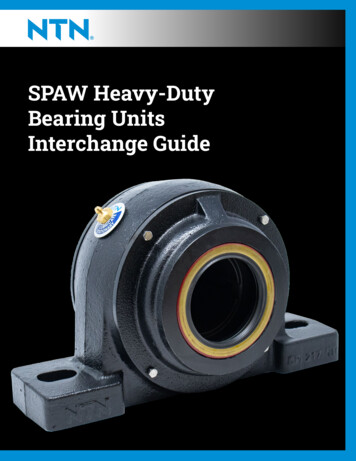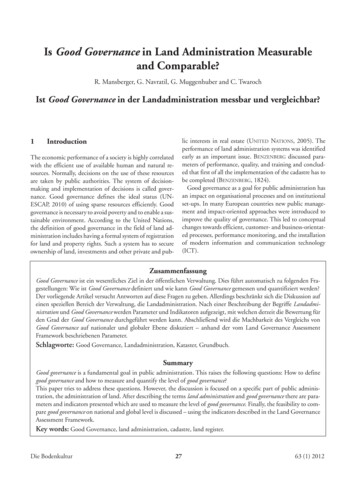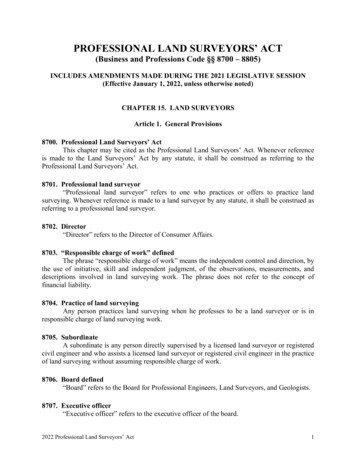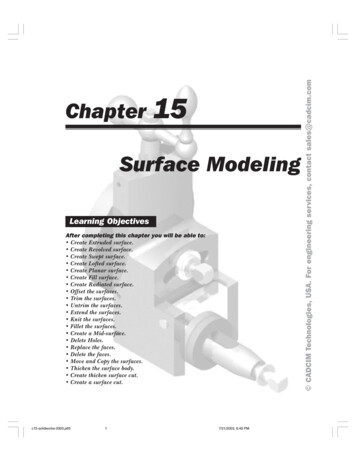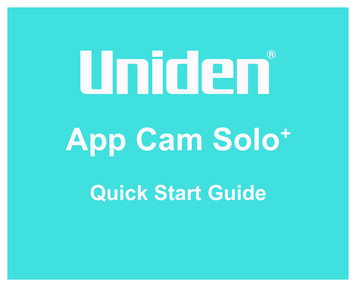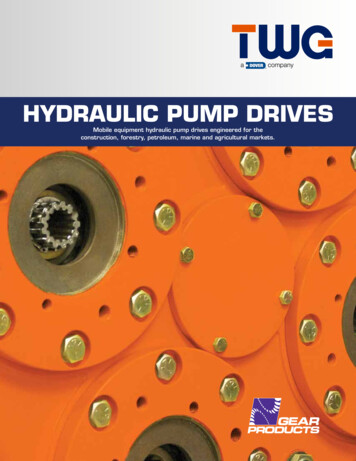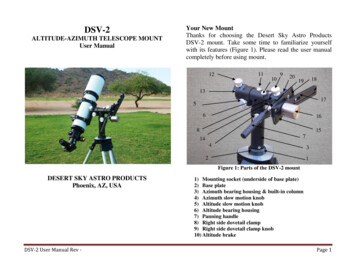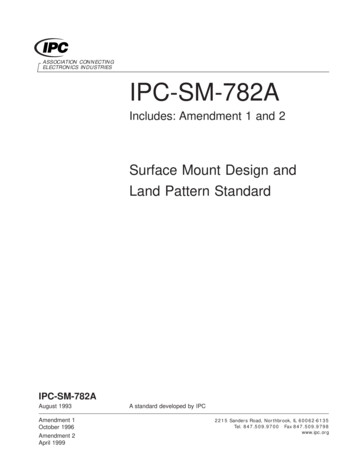
Transcription
ASSOCIATION CONNECTINGELECTRONICS INDUSTRIESIPC-SM-782AIncludes: Amendment 1 and 2Surface Mount Design andLand Pattern StandardIPC-SM-782AAugust 1993Amendment 1October 1996Amendment 2April 1999A standard developed by IPC2215 Sanders Road, Northbrook, IL 60062-6135Tel. 847.509.9700 Fax 847.509.9798www.ipc.org
The Principles ofStandardizationIn May 1995 the IPC’s Technical Activities Executive Committee adopted Principles ofStandardization as a guiding principle of IPC’s standardization efforts.Standards Should: Show relationship to Design for Manufacturability(DFM) and Design for the Environment (DFE) Minimize time to market Contain simple (simplified) language Just include spec information Focus on end product performance Include a feedback system on use andproblems for future improvementNoticeStandards Should Not: Inhibit innovation Increase time-to-market Keep people out Increase cycle time Tell you how to make something Contain anything that cannotbe defended with dataIPC Standards and Publications are designed to serve the public interest through eliminatingmisunderstandings between manufacturers and purchasers, facilitating interchangeability andimprovement of products, and assisting the purchaser in selecting and obtaining with minimumdelay the proper product for his particular need. Existence of such Standards and Publicationsshall not in any respect preclude any member or nonmember of IPC from manufacturing or selling products not conforming to such Standards and Publication, nor shall the existence of suchStandards and Publications preclude their voluntary use by those other than IPC members,whether the standard is to be used either domestically or internationally.Recommended Standards and Publications are adopted by IPC without regard to whether theiradoption may involve patents on articles, materials, or processes. By such action, IPC doesnot assume any liability to any patent owner, nor do they assume any obligation whatever toparties adopting the Recommended Standard or Publication. Users are also wholly responsiblefor protecting themselves against all claims of liabilities for patent infringement.IPC PositionStatement onSpecificationRevision ChangeIt is the position of IPC’s Technical Activities Executive Committee (TAEC) that the use andimplementation of IPC publications is voluntary and is part of a relationship entered into bycustomer and supplier. When an IPC standard/guideline is updated and a new revision is published, it is the opinion of the TAEC that the use of the new revision as part of an existingrelationship is not automatic unless required by the contract. The TAEC recommends the useof the lastest revision.Adopted October 6. 1998Why is therea charge forthis standard?Your purchase of this document contributes to the ongoing development of new and updatedindustry standards. Standards allow manufacturers, customers, and suppliers to understand oneanother better. Standards allow manufacturers greater efficiencies when they can set up theirprocesses to meet industry standards, allowing them to offer their customers lower costs.IPC spends hundreds of thousands of dollars annually to support IPC’s volunteers in thestandards development process. There are many rounds of drafts sent out for review andthe committees spend hundreds of hours in review and development. IPC’s staff attends andparticipates in committee activities, typesets and circulates document drafts, and follows allnecessary procedures to qualify for ANSI approval.IPC’s membership dues have been kept low in order to allow as many companies as possibleto participate. Therefore, the standards revenue is necessary to complement dues revenue. Theprice schedule offers a 50% discount to IPC members. If your company buys IPC standards,why not take advantage of this and the many other benefits of IPC membership as well? Formore information on membership in IPC, please visit www.ipc.org or call 847/790-5372.Thank you for your continued support. Copyright 1999. IPC, Northbrook, Illinois. All rights reserved under both international and Pan-American copyright conventions. Anycopying, scanning or other reproduction of these materials without the prior written consent of the copyright holder is strictly prohibited andconstitutes infringement under the Copyright Law of the United States.
IPC-SM-782AASSOCIATION CONNECTINGELECTRONICS INDUSTRIESSurface Mount Designand Land PatternStandardDeveloped by the Surface Mount Land Patterns Subcommittee (1-13)of the Printed Board Design Committee (1-10) of IPCUsers of this standard are encouraged to participate in thedevelopment of future revisions.Contact:IPC2215 Sanders RoadNorthbrook, Illinois60062-6135Tel 847 509.9700Fax 847 509.9798
IPC-SM-782ADecember 1999AcknowledgmentAny Standard involving a complex technology draws material from a vast number of sources. While the principal membersof the IPC Surface Mount Land Patterns Subcommittee of the Printed Board Design Committee are shown below, it is notpossible to include all of those who assisted in the evolution of this Standard. To each of them, the members of the IPCextend their gratitude.Printed Board DesignCommitteeSurface Mount Land PatternsSubcommitteeTechnical Liaison of theIPC Board of DirectorsChairmanJoe FjelstadTessera Inc.ChairmanNick MesciaGeneral DynamicsAdvanced TechnologyStan GentryNoble Industries Ltd.Surface Mount Land Patterns SubcommitteeAnderson, R., AT&T InterconnectCenter of ExcellenceArtaki, I., Lucent Technologies Inc.Baker, R.J., Central Texas ElectronicsAssociation (CTEA)Banks, S., Trimble NavigationBarlow, M., Lytton Inc.Belin, J., Automata Inc.Berkman, E., Excalibur Systems Inc.Bittle, D.W., Raytheon AircraftCompanyBoerdner, R.W., EJE ResearchBourque, J., Shure Brothers Inc.Brydges, P., Panametrics Inc.Burg, J.S., 3M CompanyCash, A.S., Northrop GrummanCorporationCaterina, J., Northrop GrummanCorporationClifton, L., Intel CorporationCohen, L., Formation Inc.Collins, S., Texscan CorporationCouble, E.C., Shipley Co.Coucher, M.M., Sequent ComputerSystems Inc.Crowley, B., Hewlett PackardLaboratoriesD’Andrade, D., The Surface MountTechnology Centre Inc.Daugherty, D., Siemens Energy &AutomationDavy, J., Northrop GrummanElectronic Sensors & Systems DivDieffenbacher, W.C., LockheedMartin CorporationDiFranza, M.J., The Mitre Corp.Dolence, C., Tektronix Board BuildOperationEasterling, T., SCI Systems Inc.iiEdwards, W.J., Lucent TechnologiesInc.Eldan, E., Orbotech Inc.Engelmaier, W., EngelmaierAssociates Inc.Feldmesser, H.S., Johns HopkinsUniversityFirestein, I., Tadiran Telecom GroupFreedman, M.G., Amp Inc.Giardina, J., Miteq Inc.Grannells, R.T., United TechnologiesGray, B.W., Bull ElectronicsGray, F.L., Texas Instruments Inc.Hargreaves, L., DC. Scientific Inc.Hartsgrove, M., I-CON IndustriesInc.Hastings, D.W., Lockheed MartinAeronutronicHeath, B., TMD (TechnologyManufacturing Inc.)Hersey, R.J., Ralph Hersey &AssociatesHinton, P.E., Hinton PWBEngineeringHolland, D.L., Sanders, A LockheedMartin Co.Horton, R.N., Northrop GrummanElectronic Sensors & Systems DivHumpal, T.L., O.E.M. WorldwideHymes, L., The Complete ConnectionJawitz, M.W., Eimer CompanyJohnson, B., Pacific TestingLaboratories, Inc.Johnson, K.L., Hexacon ElectricCompanyKemp, C.A., Lockheed MartinCorporationKenyon, W.G., Global Centre forProcess ChangeKern, T., Axiom Electronics, Inc.Knapp, C.W., Litton Guidance &Control SystemsKoebert, M., Eaton Corp.Korf, D.W., Zycon CorporationKorth, C.M., Hibbing ElectronicsCorp.Kotecki, G.T., Northrop GrummanCorporationLambert, L.P., EPTAC CorporationLandolt, R.H., Enthone-OMI Inc.Maguire, J.F., Boeing Defense &Space GroupMalanchuk, D.J., Eastman Kodak Co.KADMalewicz, W.R., Siemens MedicalElectronicsMather, J.C., Rockwell InternationalMetcalf, R.J., Morton ElectronicMaterialsMiller, R.F., Lockheed MartinCorporationMiLosh, D., LTX CorporationMiosi, D., Toppan West Inc.Morton, J.H., Lockheed MartinFederal SystemsMurray, J.L., Clark-Schwebel Inc.Norton, J.S., Tektronix Inc.Officer, R., Sanders, A LockheedMartin Co.Payne, C.W., Merix CorporationPayne, J.R., Molex Electronics Ltd.Pham, H., Symbol Technologies Inc.Pope, D., Intel CorporationPorter, C., Newbridge NetworksCorporationPrachanronarong, K., GTE CSDPrasad, R., Ray Prasad ConsultancyGroupRassai, D., 3COM Corporation
December 1999Riesenbeck, J., Lytton Inc.Rietdorf, B.C., Hughes DefenseCommunicationsRudy, D., Lucent Technologies Inc.Rumps, D.W., Lucent TechnologiesInc.Russell, R., Texas Instruments Inc.Seltzer, M.L., Hughes Delco SystemsOperationsSiegel, E.S., Pace Inc.Skelly, H., Boeing Defense & SpaceGroupSmith, E., Lucent Technologies Inc.Socolowski, N., Alpha Metals Inc.Solberg, V., Tessera Inc.Stepp, L., Whittaker ElectronicSystemsIPC-SM-782ATheiler, G.P., Fluke CorporationTheroux, G., Honeywell Inc.Thompson, R.T., Loctite CorporationThrasher, H.M., Shipley Co.Torres, S., Corlund Electronics Corp.Treutler, L.E., FachverbandElektronik Design e.V.Turbini, L.J., Georgia Institute ofTechnologyVanech, R., Northrop GrummanNorden SystemsVaught, J., Hughes Aircraft Co.Virmani, N., NASA/Goddard SpaceFlight CenterVollmar, E.L, Methode ElectronicsInc.Weiner, E.M., Weiner & AssociatesInc.Weiner, M., Tadiran Telecom GroupWhite, T.M., Boeing Defense &Space GroupWilliams, J.J., Smiths IndustriesWingate, P., Amkor Electronics Inc.Winslow, H., SCI Systems Inc.Wood, M., The Surface MountTechnology Centre Inc.Woodhouse, G.P., Micron CustomMfg. Services Inc.Wooldridge, J.R., RockwellInternationalWu, F.B., Hughes Aircraft Co.John Biancini, Advanced FlexGary Ferrari, IPCCynthia Jonas, Pitney BowesVern Solberg, Tessera Inc.Vivian Vosburg, Pac-ElCover art by:IPC Designers CouncilWilliam BurtCustom Photo and Design, Inc.Special Note of AppreciationA special note of appreciation goes tothe following principle members ofthe committee who led the effort tomake this document possible.iii
December 1999IPC-SM-782ATable of Contents1.0SCOPE . 11.11.21.31.41.51.6Purpose.Performance Classification .Assembly Types .Presentation .Profile Tolerances.Land Pattern Determination .1122222.0APPLICABLE DOCUMENTS . 42.12.22.32.4IPC .Electronic Industries Association .Joint Industry Standards (IPC) .American Society of Mechanical Engineers.44553.0DESIGN REQUIREMENTS . 53.13.23.33.43.53.63.7Terms and Definitions. 5Component Acronyms . 7Dimensioning Systems . 7Design for Producibility . 17Environmental Constraints . 18Design Rules . 20Outer Layer Finishes . 344.0QUALITY AND RELIABILITY VALIDATION . 374.14.24.3Validation Techniques . 37Test Patterns—In-Process Validator . 38Stress Testing . 385.0TESTABILITY . 455.15.25.35.45.55.65.7Testing Considerations .Nodal Access.Full Nodal Access.Limited Nodal Access.No Nodal Access .Clam Shell Fixtures Impact.Printed Board Test Characteristics .6.0PACKAGING AND INTERCONNECTINGSTRUCTURE TYPES . 486.16.26.36.46.5General Considerations.Organic-Base Material P&IS.Non-Organic Base Materials .Supporting-Plane P&I Structures .Constraining Core P&I Structures .7.0ASSEMBLY CONSIDERATIONS FORSURFACE MOUNT TECHNOLOGY (SMT) . 537.17.2SMT Assembly Process Sequence . 53Substrate Preparation Adhesive,Solder Paste . 8.48.58.68.78.88.98.108.11Component Placement .Soldering .Cleaning .Repair/Rework .DISCRETE COMPONENTSChip ResistorsChip CapacitorsInductorsTantalum CapacitorsMetal Electrode Face (MELF) ComponentsSmall Outline Transistor (SOT) 23Small Outline Transistor (SOT) 89Small Outline Diode (SOD) 123Small Outline Transistor (SOT) 143Small Outline Transistor (SOT) 223Modified Through-Hole Component (TO) 2529.0COMPONENTS WITH GULLWING LEADS ONTWO SIDES9.19.29.3Small Outline Integrated Circuits (SOIC)Small Outline Integrated Circuits (SSOIC)Small Outline Package Integrated Circuit(SOPIC)Thin Small Outline PackageCeramic Flat Pack (CFP)9.49.510.010.110.210.310.453565757COMPONENTS WITH J LEADS ON TWO SIDESSmall Outline Integrated Circuits with(SOJ)–7.63 mm [0.300] Body SizeSmall Outline Integrated Circuits with(SOJ)–8.88 mm [0.350] Body SizeSmall Outline Integrated Circuits with(SOJ)–10.12 mm [0.400] Body SizeSmall Outline Integrated Circuits with(SOJ)–11.38 mm [0.450] Body SizeJ LeadsJ LeadsJ LeadsJ Leads11.0COMPONENTS WITH GULLWING LEADS ONFOUR SIDES11.111.211.311.4Plastic Quad Flat Pack (PQFP)Shink Quad Flat Pack (SQFP), SquareShrink Quad Flat Pack (SQFP), RectangularCeramic Quad Flat Pack (CQFP)12.0COMPONENTS WITH J LEADS ON FOUR SIDES12.112.212.3Plastic Leaded Chip Carrier (PLCC), SquarePlastic Leaded Chip Carrier (PLCC), RectangularLeadless Ceramic Chip Carrier (LCC)13.0MODIFIED DUAL-IN-LINE PIN (DIP)COMPONENTSiv
IPC-SM-782A13.114.014.114.2December 1999DIPCOMPONENTS WITH BALL GRID ARRAYCONTACTSPlastic Ball Grid Array1.27 mm Pitch Rectangular PBGA JEDECMS-028FiguresFigure 4–1Component temperature limits . 37Figure 4–2General description of process validationcontact pattern and interconnect. 39Figure 4–3Photo image of IPC-A-49 test board forprimary side. 39Figure 4–4Flat ribbon, ‘‘L,’’ and gullwing lead jointdescription . 40Figure 4–5Round or flattened (coined) lead jointdescription . 40Figure 1–1Electrical assembly types. 3Figure 4–6‘‘J’’ lead joint description . 41Figure 3–1Examples of typical package styles andpackage descriptive designators. 9Figure 4–7Rectangular or square end components. 41Figure 4–8Figure 3–2Lead-form (or terminal-shape) examples. 10Cylindrical end cap terminations—jointillustration . 42Figure 3–3Profile tolerancing examples . 11Figure 4–9Bottom only terminations. 42Figure 3–4Example of C1206 capacitor dimensioningfor optimum solder fillet conditions . 12Figure 4–10Leadless chip carriers with castellatedterminations—joint description . 43Figure 3–5Profile dimensioning of a gullwingleaded SOIC. 13Figure 4–11Butt joint description. 43Figure 4–12Thermal cycle excursion rate . 44Figure 3–6Pitch for multiple-leaded components. 15Figure 5–1Test via grid concepts . 47Figure 3–7Simplified electronic developmentorganization . 20Figure 5–2General relationship between test contactsize and test probe misses . 49Figure 3–8Recommended minimum land-to-landclearances . 21Figure 5–3Test probe feature distance fromcomponent. 50Figure 3–9Component orientation for wave solderapplications. 21Figure 7–1Typical process flow for undersideattachment type 2c (simple) surface mounttechnology . 54Figure 7–2Typical process flow for full surfacemount type 1b and 2b surface mounttechnology . 54Figure 7–3Typical process flow for mixed technologytype 2c (complex) surface mounttechnology . 55Figure 3–10Alignment of similar components . 22Figure 3–11Local/global fiducials . 23Figure 3–12Panel/global fiducials. 23Figure 3–13Fiducial types for vision systems . 24Figure 3–14Fiducial clearance requirements . 24Figure 3–15Fiducial locations on a printed circuit board . 25Figure 3–16Packaging and geometries. 25Figure 7–4In-line placement equipment . 55Figure 3–17Surface mount conductor widths/clearances vs. routing grids . 26Figure 7–5Simultaneous placement equipment . 55Figure 7–6Sequential placement equipment. 56Figure 3–18Section view of multilayer board withvias on 1.0 mm [0.040 in] centers . 26Figure 7–7Sequential/Simultaneous placementequipment. 56Figure 3–19Narrowed conductor . 27Figure 3–20Conductor routing. 27Figure 3–21Surface routing geometries . 28Table 3–1Terminal Position Prefixes. 8Figure 3–22Conductor routing capability test pattern . 28Table 3–2Package-Outline-Style Codes . 8Figure 3–23Routing channels under SOIC landpattern with 28 pins. 29Table 3–3Lead-Form (or Terminal-Shape) Suffixes . 11Table 3–4Tolerance Analysis Elements for Chip DevicesFigure 3–24Land pattern to via relationships. 29Table 3–5RLP Numbers. 17Figure 3–25Examples of via positioning concepts. 30Table 3–6Figure 3–26Vias under components . 30Worst-Case Environments and AppropriateEquivalent Accelerated Testing . 19Figure 3–27Conductor characteristics. 31Table 3–7Component Stand Off . 23Figure 3–28Examples of modified landscapes . 32Table 3–8Figure 3–29Typical copper glass laminate panel. 33Typical Values to Be Added or Subtracted toNominal Production to Achieve DesiredNominal Conductor Width . 31Figure 3–30Conductor clearance for V-groove scoring . 34Table 3–9Conductor Width Tolerances . 32Figure 3–31Breakaway (routed pattern). 35Table 6–1Figure 3–32Routed slots . 35Packaging and Interconnecting StructureComparison . 51Figure 3–33Gang solder mask window. 36Table 6–2P & I Structure Selection Considerations . 52Pocket solder mask windows. 36Table 6–3P & I Structure Material Properties . 52Figure 3–34vTables
December 1999IPC-SM-782AThis Page Intentionally Left Blankvi
December 1999IPC-SM-782ASurface Mount Design and Land Pattern Standard1.0 SCOPECLASS 1This document provides information on land pattern geometries used for the surface attachment of electronic components. The intent of the information presented herein is toprovide the appropriate size, shape and tolerance of surfacemount land patterns to insure sufficient area for the appropriate solder fillet, and also to allow for inspection andtesting of those solder joints.Includes consumer products, some computer and computerperipherals, as well as general military hardware suitablefor applications where cosmetic imperfections are notimportant and the major requirement is function of thecompleted printed board or printed board assembly.1.1 Purpose Although, in many instances, the land pattern geometries can be slightly different based on the typeof soldering used to attach the electronic part, whereverpossible, land patterns are defined in such a manner thatthey are transparent to the attachment process being used.Designers should be able to use the information containedherein to establish standard configurations not only formanual designs but also for computer aided design systems. Whether parts are mounted on one or both sides ofthe board, subjected to wave, reflow, or other type of soldering, the land pattern and part dimensions should be optimized to insure proper solder joint and inspection criteria.Although patterns are standardized, since they are a part ofthe printed board circuitry geometry, they are subject to theproducibility levels and tolerances associated with plating,etching, or other conditions. The producibility aspects alsopertain to the use of solder mask and the registrationrequired between the solder mask and the conductor patterns. (See paragraph 1.2.2).1.2 Performance Classification Three general endproduct classes have been established in associated IPCstandards and specifications to reflect progressive increasesin sophistication, functional performance requirements andtesting/inspection frequency. It should be recognized thatthere may be an overlap of equipment between classes.Design requirements determine class. Class definitions areuseful for identifying degrees of precision needed to meetdesign/performance requirements of packaging and interconnecting structures, and establish communication mediabetween design and manufacture and disciplines.The printed board user has the responsibility to determinethe class to which his product belongs. The contract shallspecify the performance class required and indicate anyexceptions to specific parameters, where appropriate. In theevent of conflict between the design requirements and theclasses defined herein, the former shall take precedenceand be reflected in the master drawing.These classes are:CLASS 2General Electronic ProductsDedicated Service Electronic ProductsIncludes communications equipment, sophisticated business machines, instruments and military equipment wherehigh performance and extended life is required, and forwhich uninterrupted service is desired but is not critical.Certain cosmetic imperfections are allowed.CLASS 3High Reliability Electronic ProductsIncludes the equipment for commercial and military products where continued performance or performance ondemand is critical. Equipment downtime cannot be tolerated, and functionality is required for such applications aslife support items, or missile systems. Printed boards andprinted board assemblies in this class are suitable for applications where high levels of assurance are required andservice is essential.The land patterns in this standard have the capability ofaccommodating all three performance classifications.1.2.1 End-Use Applications In addition to the three performance classifications, the Surface Mount Council hasestablished end use applications for electronic products.These are:1.Consumer products including games, toys, audio andvideo electronics. In general, convenient size andmaximum functionality are important but product costis extremely important.2.General purpose computers, as used in businesses andpersonal applications. Compared to consumer products, customers expect longer life and more consistentservice.3.Telecom products including telephone, switching systems, PBXs, and exchanges. These products are usedin applications expecting long service life and enduring relatively harsh environments.4.Commercial aircraft requiring small size, light weightand high reliability.5.Industrial products and passenger compartment automotive applications. Size and function is a byword ofthese products. Cost is very important, provided thatreducing product cost doesn’t forfeit the highestachievable product quality, performance, and function.1
IPC-SM-782A6.December 1999High performance products consisting of ground-basedand shipbound military products, high speed and highcapacity computers, critical process controllers, andlife supporting medical systems. Quality, reliabilityand performance are paramount, closely followed bysize and function. Cost is optimized based on theserequirements but is less important.7.Space products include all of the products above whichare built to meet harsh outer space conditions. Thisimplies high quality and performance over a widerange of environmental and physical extremes.8.Military avionics products built to meet demandingmechanical and thermal changes. Size, weight, performance and reliability are paramount.9.Under the hood automotive electronics productsendure the harshest of all use environments. Theseproducts face extreme temperatures and mechanicalvariations. Adding to this is the pressure of achievingthe lowest cost and optimum manufacturability in highvolumes.1.2.2 Producibility Levels When appropriate this standard will provide three design complexity levels of features, tolerances, measurements, assembly, testing ofcompletion or verification of the manufacturing processthat reflect progressive increases in sophistication of tooling, materials or processing and, therefore progressiveincreases in fabrication cost. These levels are:Level AGeneral Design Complexity—PreferredLevel BModerate Design Complexity—StandardLevel CHigh Design Complexity—Reduced ProducibilityProducibility levels also pertain to the assembly. The threecomponent mounting complexity levels which reflect progressive increases in sophistication of tooling, assemblyand joining techniques and therefore progressive increasesin cost are:Level Asimple assembly techniques used to describethrough the board component mounting;Level Bmoderate assembly techniques used todescribe surface component mounting andLevel Ccomplex assembly techniques used todescribe intermixing of through-the-boardand surface mounting on the same assembly.Classification of complexity should not be confused withthe performance classification of end-item use described inparagraph 1.2.1.3 Assembly Types A type designation signifies furthersophistication describing whether components are mounted2on one or both sides of the packaging and interconnectingstructure. Type 1 defines an assembly that has componentsmounted on only one side; type 2 is an assembly withcomponents on both sides. Type 2 is limited to only classB or C assemblies.Figure 1–1 shows the relationship of two types of assemblies.The need to apply certain design concepts should dependon the complexity and precision required to produce a particular land pattern or P&I structure. Any design class maybe applied to any of the end-product equipment categories;therefore, a moderate complexity (Type 1B) would definecomponents mounted on one side (all surface mounted) andwhen used in a Class 2 product (dedicated service electronics) is referred to as Type 1B, Class 2. The productdescribed as a Type 1B, Class 2 might be used in any of theend-use applications; the selection of class being dependenton the requirements of the customers using the application.1.4 Presentation Dimensions and tolerances areexpressed in millimeters (mm) or microns (mn) as appropriate. When no unit of measurement is shown, the unitshall be assumed to be ‘‘mm.’’ Reference information forinch conversion is shown in the appendix.Profile tolerances are used in thedimensioning system for determining the relationshipbetween component outlines and land pattern geometries.The details are described in Section 3.3, and follow theprinciples set forth in ANSI Y14.5. All dimensions are considered maximum or minimum material condition (depending on the features being analyzed), thus the profile tolerances are unilateral (one-direction—maximum tominimum, or minimum to maximum) as opposed to bilateral (plus or minus) from a nominal characteristic.1.5 Profile Tolerances1.6 Land Pattern DeterminationThis document discusses two methods of providing information on land patterns:(1) exact details based on industry component specifications, board manufacturing and component placementaccuracy capabilities. These land patterns are registered to a specific component, and have a registeredland pattern number, see Table 3.5 and paragraph3.3.3.4.(2) equations that can be used to alter the given information to achieve a more robust solder connection, whenused in particular situations where the equipment forplacement or attachment are more or less precise thanthe assumptions made when determining the exact landpattern details.In general, a product is agood candidate for SMT if it needs to be:1.6.1 General Usage of SMT
December 19
IPC-SM-782A Includes: Amendment 1 and 2 Surface Mount Design and Land Pattern Standard ASSOCIATION CONNECTING ELECTRONICS INDUSTRIES 2215 Sanders Road, Northbrook, IL 60062-6135 Tel. 847.509.9700 Fax 847.509.9798 www.ipc.org IPC-SM-782A August 1993 A standard developed by IPC Amendment 1 October 1996 Amendment 2 April 1999

